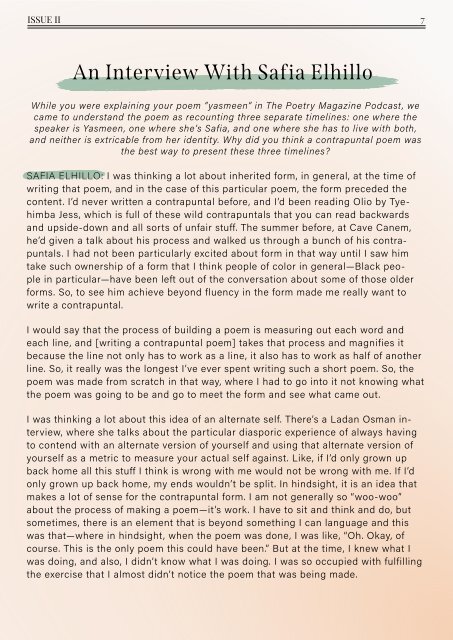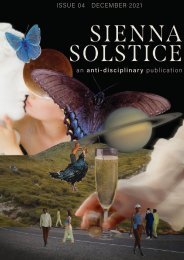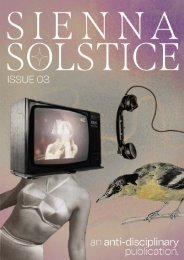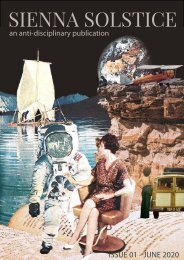ISSUE II
Create successful ePaper yourself
Turn your PDF publications into a flip-book with our unique Google optimized e-Paper software.
<strong>ISSUE</strong> <strong>II</strong> 7<br />
An Interview With Safia Elhillo<br />
While you were explaining your poem “yasmeen” in The Poetry Magazine Podcast, we<br />
came to understand the poem as recounting three separate timelines: one where the<br />
speaker is Yasmeen, one where she’s Safia, and one where she has to live with both,<br />
and neither is extricable from her identity. Why did you think a contrapuntal poem was<br />
the best way to present these three timelines?<br />
SAFIA ELHILLO: I was thinking a lot about inherited form, in general, at the time of<br />
writing that poem, and in the case of this particular poem, the form preceded the<br />
content. I’d never written a contrapuntal before, and I’d been reading Olio by Tyehimba<br />
Jess, which is full of these wild contrapuntals that you can read backwards<br />
and upside-down and all sorts of unfair stuff. The summer before, at Cave Canem,<br />
he’d given a talk about his process and walked us through a bunch of his contrapuntals.<br />
I had not been particularly excited about form in that way until I saw him<br />
take such ownership of a form that I think people of color in general—Black people<br />
in particular—have been left out of the conversation about some of those older<br />
forms. So, to see him achieve beyond fluency in the form made me really want to<br />
write a contrapuntal.<br />
I would say that the process of building a poem is measuring out each word and<br />
each line, and [writing a contrapuntal poem] takes that process and magnifies it<br />
because the line not only has to work as a line, it also has to work as half of another<br />
line. So, it really was the longest I’ve ever spent writing such a short poem. So, the<br />
poem was made from scratch in that way, where I had to go into it not knowing what<br />
the poem was going to be and go to meet the form and see what came out.<br />
I was thinking a lot about this idea of an alternate self. There’s a Ladan Osman interview,<br />
where she talks about the particular diasporic experience of always having<br />
to contend with an alternate version of yourself and using that alternate version of<br />
yourself as a metric to measure your actual self against. Like, if I’d only grown up<br />
back home all this stuff I think is wrong with me would not be wrong with me. If I’d<br />
only grown up back home, my ends wouldn’t be split. In hindsight, it is an idea that<br />
makes a lot of sense for the contrapuntal form. I am not generally so “woo-woo”<br />
about the process of making a poem—it’s work. I have to sit and think and do, but<br />
sometimes, there is an element that is beyond something I can language and this<br />
was that—where in hindsight, when the poem was done, I was like, “Oh. Okay, of<br />
course. This is the only poem this could have been.” But at the time, I knew what I<br />
was doing, and also, I didn’t know what I was doing. I was so occupied with fulfilling<br />
the exercise that I almost didn’t notice the poem that was being made.






